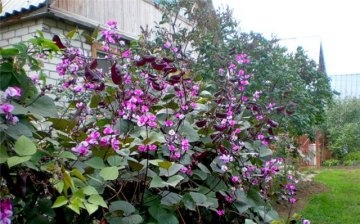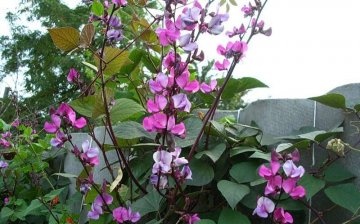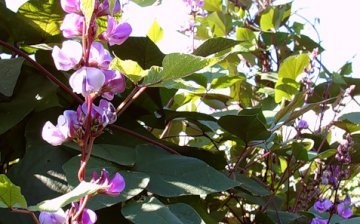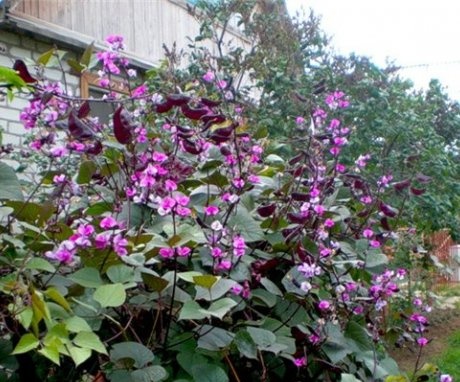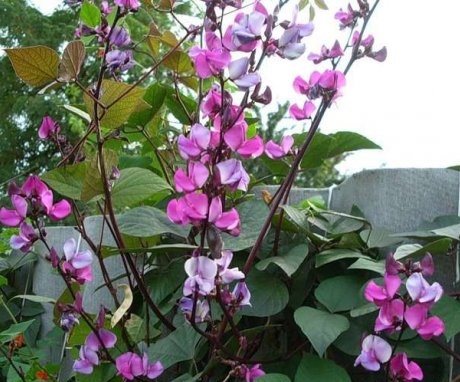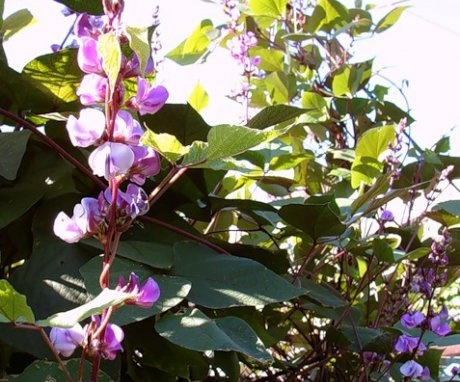Growing dolichos, or curly lilac
An unusual and bright liana called dolichos, whose shoots (15-20) twine around the support in the opposite direction to the clockwise movement and can reach four meters in length. The diameter of the bush is about a meter. The people mainly call this vine, which is part of the legume family, curly lilac, hyacinth or Egyptian beans. There are other interesting names for this plant - lablab and lobia.
Content:
Origin and growth
The origin of the plant has not been clarified. In nature, dolichos lives in East Africa and many regions of India, Brazil, Colombia and Cuba, where it is a perennial plant and can reach ten meters in height.
Using dolichos
This plant appeared in our gardens relatively recently, but today dolichos has become a favorite of many flower growers who adore original plants.
With its small moth-shaped white, yellow and pinkish-lilac flowers that exude a pleasant sweet aroma, and large heart-shaped leaves, this plant is extremely valuable from a decorative point of view: its picturesque shoots are ideal for landscaping terraces, gazebos and fences, as well as creating pergolas and arches. It goes well with tall plants with bright flowers. Looks perfect with clematis... Excellent neighbors for dolichos will be peonies, tulips and dahlias.
Dolichos pleases with its graceful half-meter racemose inflorescences, consisting of 40 or 50 flowers, from mid-summer to the first frost. The flowers in the inflorescence change each other every 3 days. The inflorescence itself stays on the plant for about 3 weeks.
In addition, its fruits are edible: in India and Africa, the cultivation of dolichos is carried out precisely for the sake of green, purple and white pods, which contain a huge amount of protein, vitamins and minerals and resemble common beans in taste.
In addition to all its virtues, lobia, like all its relatives, enriches the soil with nitrogen.
Dolichos care
Dolichos is a tropical plant. Therefore, you should choose a warm, well-lit place for it. It develops best at a temperature of + 18-25 degrees. If you plant it in the shade, then the flowers can not wait. If, nevertheless, the liana blooms, then the flowers will not differ in special beauty.
In the first month after planting, dolichos should be watered as often as possible, since the young plant reacts very badly to the slightest lack of moisture. As they grow older, the dolichos's drought resistance increases, and watering can be done less frequently. But still, during a drought, dolichos should be watered more often. In this case, it is impossible to overmoisten the soil: rotting of the roots is possible.
Since this plant is climbing, it needs some kind of support (preferably large enough) along which its shoots will curl.
Reproduction
Dolichos can be propagated by its seeds - beans, which do not lose their usefulness for 5 years. In early April, they should be planted in cups, before that they must have been kept in water or in potato juice for a day.
It is recommended to damage the casing by rubbing it with sandpaper or puncturing it with a needle. Such actions will accelerate seed germination.
It is necessary to ensure that the room temperature is maintained above +20 degrees.After the soil has completely warmed up, small seedlings can be transferred to open ground, planting at a distance of about half a meter. When replanting a plant, great care should be taken due to the fragility of the root system.
Sowing seeds in open ground is possible. It should be borne in mind that the cultivation of dolichos is possible only in fertile loose soil, and this rather unpretentious plant does not tolerate strongly alkaline and acidic soils.
IN dressing curly lilac does not really need it, but still it is advisable to feed it 2 times a month in order to prolong flowering. It is best to use nitrogen fertilizers first to build up vegetative mass, and then potash fertilizers to stimulate flowering. But in any case, complex fertilizers are suitable.
Wintering
In our climate, Egyptian beans usually do not survive the winter and are grown as an annual. But in the southern regions, you can try to shorten and cover the shoots: if the winter is not too harsh, then the plant will happily survive until spring.
Pests and diseases
Hyacinth beans are extremely resistant to pests and diseases. But with a lack of potassium, small yellow spots may appear on the leaves. The development of powdery mildew and fungal leaf spot is possible. Occasionally, aphids, caterpillars and root nodular nematodes can be seen on the plant.
On autumn days, when the surrounding nature darkens the eyes with monotony, dolichos stands out with a variety of colors. Young green and purple foliage, yellow old leaves and multi-colored beans grow on the bush at the same time.




